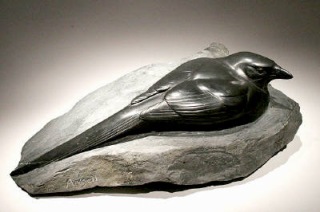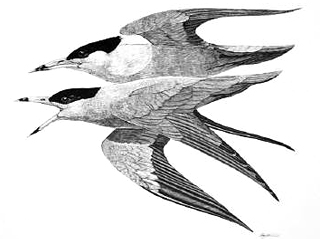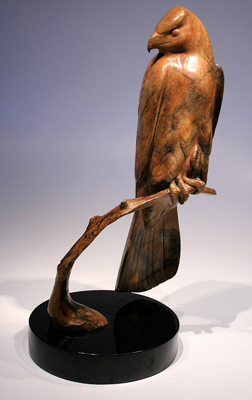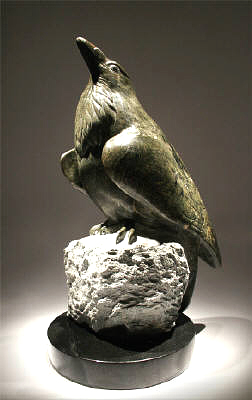Art has power to move people in deep and enduring ways. For decades, sculptor and painter Tony Angell has created images of the birds, fish and other wildlife of his adopted Salish Sea.
This week, Liam Moriarty visits Angell in his Seattle-area studio to talk about what inspires his work and how it can inspire others.
Click to listen to the story
Liam Moriarty: You were raised on southern California, around Los Angeles?
Tony Angell: I was out in the San Fernando Valley. At the time, when I was a kid, there was still a wild area there that a youngster could roam around in. I started drawing and painting the subjects that I would see in the California foothills or along the beaches.
By the time I finished high school, I had seen that whole area change dramatically. So when I came to the Northwest at 17 to attend the University of Washington, I had already, I think, cut my teeth a little bit on not only being out in nature but also understanding that that’s not something you can take for granted because I’d seen it disappear there.
Liam: How did that influence your artwork?
Tony: Most of my subject matter that occupies this region; everything from the fish that I’ve seen diving in Puget Sound or the falcons and owls that come here in winter along the Skagit or the Samish.
Liam: We’re here in your studio, and you’re working on a bird right now on your table. Could we look at that – talk about that?
Tony: Yeah; what you’re looking at is a plover. It’s a carving in stone.
Liam: It’s sort of lying there as though in the sand, and it’s got one wing sort of laid out on the sand. You can see each feather and each of the cuts. It’s a gorgeous –
Tony: Thank you.
It’s a gesture; that’s the emphasis. Even though I think I do address matters of detail and I am generally sensitive to accuracy of my detail, I don’t put a lot of it into my work. What I am trying to do is emphasize the spiritual side of the subject.
Liam: When you are bringing something like this plover out of the stone, what’s that process? I suspect there’s – I suspect there are certain technical considerations in terms of the stone and the tools and things like that – but how does that process work for you?
Tony: I’ll go out into the field. And, there are times that I go out, knowing even before I get there, I’m going to see something, even to the point of knowing what I’m going to see. Part of it is being familiar with the area. Part of it is understanding the time of year that I ought to see it, knowing the favorite haunts of that subject – but there’s more to it than that.
It’s taken my entire life to realize that there’s something that may never come into consciousness that we are equipped with as people. Because it doesn’t come into consciousness, sometimes you deny the opportunity to employ it.
I don’t know what it is. I really don’t know what it is and I’m not going to try to analyze it. I just want to keep it.
Liam: Are there ways in which your representations of the creatures that live in the Salish Sea encourages or opens the door to people seeing things about the local waters that perhaps they might
Tony: I think sculptural art invites a lot of engagement because it’s not only visual, it’s tactile. It’s kinesthetic because there’s a gesture there, and you start stretching your wings, so to speak. It has a sound to it. You tap it with a chisel and you can hear the sound.
When this piece is finished and I put a coat of wax on it, you could probably lightly tap the bill with a pencil and it would ring like a piece of ceramic.
Liam: It invites you to touch it, too.
Tony: Well, it does.
Liam: Given the challenges that the Salish Sea faces as an ecological system, we’ve all heard all the bad news and the scientific studies and declines of species and pollution and all that sort of stuff. It’s hard a lot of times for people to want to hear more of that.
Do you think that the artistic images of creatures and other aspects of the natural world can kind of keep people open to an engagement that otherwise they might kind of shy away from because of all the bad news?
Tony: Absolutely. I think that was the premise that I put this last book together, “Puget Sound Through an Artist’s Eye,” and the People for Puget Sound, citizens’ group, had used the book in a variety of venues to introduce people to Puget Sound rather than with a threat – you’re going to lose this, you’re going to lose that – as true as it may be, as you say, people are turned off by it. They seal themselves up with a video and forget the world outside.
This is an invitation to enjoy the world artistically, and in a way, inspire other people to be artists. Because there are plenty of people out there who can use art as their avenue of discovery and action and commitment and enjoyment of living here.
Once you do that, you’ve invested in what’s here.






